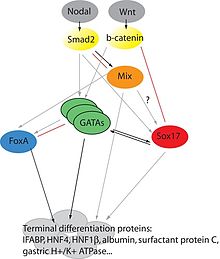The GATA transcription factor family consists of six DNA-binding proteins (GATA1-6) that regulates transcription of DNA due to their ability to bind to the DNA sequence "GATA" which can therefore affect different diseases.[1][2][3]

These six proteins are divided into two subfamilies of GATA1/2/3 and GATA4/5/6 based on differences in differentiation of stem cell tissues.[2] All six proteins are required for differentiating mesoderm derived tissues. The difference is that GATA1/2/3 is required in development and differentiation of ectoderm derived tissues (such as hematopoietic and the central nervous system), while GATA 4/5/6 is for differentiation of endoderm derived tissues (such as embryonic stem cells of the heart and skin.[2] Mutations in the GATA gene leads to problems in the thyroid, ears, kidney, heart, and can cause cancer.[2] GATA can be used as biomarkers in predicting different diseases such as acute megakaryoblastic leukemia (AMKL) in Down syndrome, colorectal, and breast cancer.[2]
GATA transcription factors have been correlated to their broader influence on stem cell development. Findings however, have pointed to a more direct influence by GATA transcription factors, as they are salient components in the more concentrated regulation of gene expression. Data points to the roles GATA transcription factors play in stages past early development in endocrine organs.[4]
- ^ Ko LJ, Engel JD (July 1993). "DNA-binding specificities of the GATA transcription factor family". Molecular and Cellular Biology. 13 (7): 4011–4022. doi:10.1128/mcb.13.7.4011. PMC 359950. PMID 8321208.
- ^ a b c d e Lentjes, Marjolein HFM; Niessen, Hanneke EC; Akiyama, Yoshimitsu; de Bruïne, Adriaan P; Melotte, Veerle; van Engeland, Manon (2016). "The emerging role of GATA transcription factors in development and disease". Expert Reviews in Molecular Medicine. 18: e3. doi:10.1017/erm.2016.2. ISSN 1462-3994. PMC 4836206. PMID 26953528.
- ^ Lowry, Jason A.; Atchley, William R. (17 September 1999). "Molecular Evolution of the GATA Family of Transcription Factors: Conservation Within the DNA-Binding Domain". Journal of Molecular Evolution. 50 (2): 103–115. doi:10.1007/s002399910012. PMID 10684344 – via Springer Link.
- ^ Viger RS, Guittot SM, Anttonen M, Wilson DB, Heikinheimo M (April 2008). "Role of the GATA family of transcription factors in endocrine development, function, and disease". Molecular Endocrinology. 22 (4): 781–798. doi:10.1210/me.2007-0513. PMC 2276466. PMID 18174356.